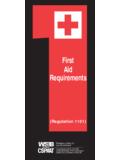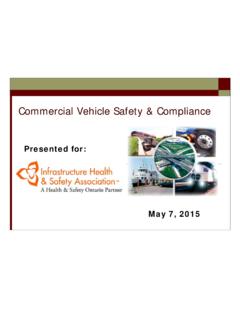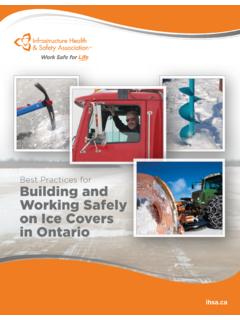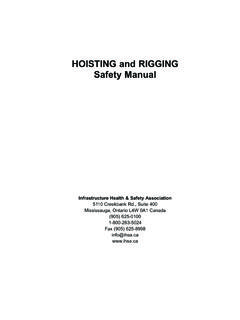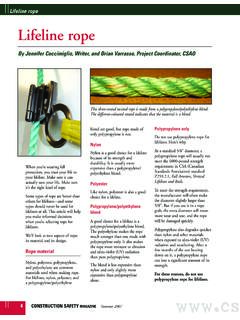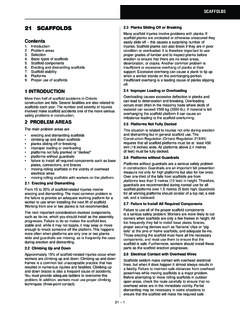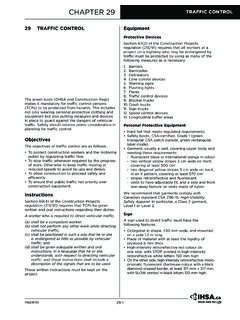Transcription of 26 ELECTRICAL HAZARDS - IHSA
1 Hazards26-1 ELECTRICAL HAZARDSCHAPTER 2626 ELECTRICAL HAZARDSAn ELECTRICAL hazard can be defined as -a dangerous condition where a worker could make ELECTRICAL contact with energized equipment or a conductor, and from which the person may sustain an injury from shock; and/or, -there is potential for the worker to receive an arc flash burn, thermal burn, or blast injury. Injuries resulting from a worker making ELECTRICAL contact represent a relatively small portion ( ) of the lost-time injuries electricians experience, according to 1997 1999 statistics. It is reasonable to assume that the situation is similar today. Other mechanical trades that do some ELECTRICAL work can probably expect even fewer ELECTRICAL injuries. Nevertheless, working on or near ELECTRICAL HAZARDS is dangerous and can be fatal. Any work on or near energized equipment must be done only when measures are in place to provide protection from electric shock and burn.
2 With adequate safety measures in place, every ELECTRICAL injury and fatality can be prevented. The law requires safe work practices. Under the Occupational Health and Safety Act and regulations for Construction Projects (the green book), employers, supervisors, and workers each have legal responsibilities to ensure that work is being carried out in a safe manner. NOTE: An ELECTRICAL hazard is considered to be removed when protective measures are put in place at the source (remove hazard or de-energize), or along the path (place ELECTRICAL insulation/barrier between the worker and the ELECTRICAL hazard). Where PPE is relied upon for worker protection, an ELECTRICAL hazard is considered to remain and it is still necessary to address safety requirements for other workers in the are also restrictions in the Construction Projects regulation (O.)
3 Reg. 213/91, s. 182) on who can work on ELECTRICAL equipment:1. No worker shall connect, maintain or modify ELECTRICAL equipment or installations unless,(a) the worker holds a certificate of qualification issued under the Ontario College of Trades and Apprenticeship Act, 2009, that is not suspended, in the trade of,(i) electrician construction and maintenance, or(ii) electrician domestic and rural, if the worker is performing work that is limited to the scope of practice for that trade; or(b) the worker is otherwise permitted to connect, maintain or modify ELECTRICAL equipment or installations under the Ontario College of Trades and Apprenticeship Act, 2009 or the Technical Standards and Safety Act, 2000. O. Reg. 627/05, s. 4; O. Reg. 88/13, s. A worker who does not meet the requirements of clause (1) (a) or (b) may insert an attachment plug cap on the cord of ELECTRICAL equipment or an ELECTRICAL tool into, or remove it from, a convenience for working on or near ELECTRICAL equipment and conductors are found in several documents: Construction Regulation (O.
4 Reg. 213/91) Ontario ELECTRICAL Safety Code Operating manuals for different tools and equipment. CAN/CSA-Z462: Workplace ELECTRICAL important aspect of ELECTRICAL work involves isolating ELECTRICAL energy. A reference for detailed information on lockout and control of hazardous energy is the CAN/CSA-Z460: Control of Hazardous Energy Lockout and Other Methods. ELECTRICAL InjuriesThere are basically two ways to be injured by electricity. One is by electric shock and the other is by arc shock is the passing of electric current through the body. ELECTRICAL contact can cause involuntary physical movements. The ELECTRICAL current may do the following. Prevent you from releasing your grip from a live conductor Throw you into contact with a higher voltage conductor Cause you to lose your balance and fall Cause severe internal and external burns Kill household 125-volt circuit can deliver 15 amps.
5 Current as low as 30/1000 of 1 amp (30 mA) can cause breathing to stop. A 15-amp circuit contains many times the current needed to cause Health and Safety ManualELECTRICAL HAZARDSA major cause of accidents involving electricity comes from the failure to identify the HAZARDS associated with live ELECTRICAL equipment and wiring (Figure 26-1).Figure 26-1: ELECTRICAL InjuriesAn arc flash is a release of energy caused by an electric arc (Figure 26-2). The flash causes an explosive expansion of air and metal. The blast produces A dangerous pressure wave A dangerous sound wave Shrapnel Extreme heat Extreme 26-2: Electric ArcThese dangers can result in blast injuries, lung injuries, ruptured eardrums, shrapnel wounds, severe burns, and blindness. Arc flash injuries can also result in death (Figure 26-3).Figure 26-3: Arc FlashSafeguardsProtective Tools and EquipmentWorkers exposed to an ELECTRICAL hazard must use mats, gloves, shields, flame resistant clothing, and any other protective equipment required to protect themselves from electric shock and burn.
6 As part of everyday work, ELECTRICAL workers should always do the following. Remove watches, rings, neck chains, or other current-conducting apparel. Wear electric-shock-resistant footwear. Wear a CSA-approved Class E hard hat or equivalent. Wear safety glasses with side shields. Wear under and outer clothing that has flame-resistance , devices, and equipment including personal protective equipment used for live work must be designed, tested, maintained, and used so as to provide adequate protection for workers. Where there is the potential for an arc flash, all PPE should be chosen with consideration for the kinds of HAZARDS that can result from an arc flash. (See "Flash hazard arc flash protection" below.)The following information provides guidelines on appropriate and required personal protective equipment.
7 Check the reference documents identified at the beginning of this chapter to determine your job-specific needs. See also the chapters on personal protective equipment in this or not the day s planned work involves working near an ELECTRICAL hazard, workers that do ELECTRICAL work should choose everyday clothing that offers some flame-resistance properties. When work must be done in the presence of an ELECTRICAL hazard, ensure that all clothing is chosen to provide adequate protection from the potential HAZARDS . (See "Flash Hazard (Arc Flash) Protection" section in this chapter.)Head ProtectionThe following types of hard hats comply with the Construction Projects regulation (213/91): Class E, Type 1 or 2 ( ) Type II, Class E (ANSI ) Type I, Class E (ANSI ).Type 1 hard hats provide protection to the top of the head, while Type 2 hard hats provide protection to the top and sides of the head.
8 Because it protects against side impact, CSA Type 2 hard hats are recommended for construction work. Class E hard hats are able to withstand an ELECTRICAL contact equal to 20,000 volts (phase-to-ground).Hazards26-3 ELECTRICAL HAZARDSFoot ProtectionConstruction workers require Grade 1 toe protection with sole puncture protection in accordance with CAN/CSA Z195-14: Protective Footwear. A green triangular patch on the tongue or the ankle of protective footwear indicates that it meets the requirements of the Construction Projects regulation (213/91).Construction workers who are exposed to ELECTRICAL HAZARDS ( , mechanical tradespeople) should also wear protective footwear that resists electric shock. This is indicated by a white rectangular label bearing the CSA logo and the Greek letter omega in logoomega labelEye ProtectionCAN/CSA : Eye and Face Protectors can assist you in classifying HAZARDS and recommending eye protectors.
9 Appropriate protection chosen according to this standard meets with the intent of the Construction Projects regulation (213/91) regarding eye protection worn on the any case, eye protection should be of industrial quality eye protection in the form of safety glasses incorporating side-shields or a wrap-around style. Arc flash protection requires a face shield that is rated for arc flash, with safety glasses plastic face shields do not to provide arc flash protection. They can burn and melt in an arc flash incident. Use a face shield that is designed and rated for arc flash protection. Hearing Protection Hearing protection is important at work since continuous exposure to excessive noise can lead to hearing loss and tinnitus. Hearing protection is required for some arc flash HAZARDS . Hearing protection is available in three general types:1.
10 Disposable ear plugs made of pliable material. One size fits all, but they should only be used Reusable custom-fit ear plugs are available to provide protection for specific frequencies of noise. These provide a good seal and can be washed and Earmuffs. They need to be fitted to provide maximum protection. Shock ProtectionThe passage of electricity through the body is called shock. Effects can range from a tingling sensation to death. A shock that may not be enough to cause injury can nonetheless startle a worker, causing an involuntary reaction that can result in serious injuries or household 125-volt circuit can deliver 15 amps. Current as low as 30/1000 of 1 amp (30 mA) can cause breathing to stop. A 15-amp circuit has many times the current needed to cause gloves and leather protectors are the most common personal protective equipment used for shock protection.

